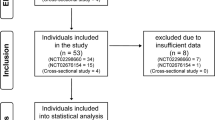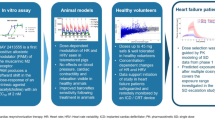Abstract
There exists a growing body of evidence linking depression with cardiovascular events, although the mechanisms responsible remain unknown. We investigated the role of the autonomic nervous system and inflammation in the link between coronary heart disease and major depressive disorder (MDD), and examined the cardiac risk modification following pharmacological treatment of depression. We measured cardiac baroreflex function, heart rate variability, pulse pressure and high sensitivity C-reactive protein (hsCRP), all of which have an impact on cardiac risk, pre- and post-treatment in 25 patients with MDD, with no history of coronary heart disease, and in 15 healthy subjects. Treatment consisted of selective serotonin reuptake inhibitors for approximately 12 weeks. No significant differences were observed between untreated MDD patients and healthy subjects in blood pressure, heart rate, baroreflex sensitivity or heart rate variability. Pulse pressure and hsCRP, however, were significantly elevated in patients with MDD prior to treatment (p=0.023 and p=0.025, respectively). Moreover, while pharmacotherapy was effective in alleviating depression, surprisingly, each of cardiac baroreflex function, heart rate variability, pulse pressure and hsCRP was modified (p<0.05) in a manner likely to increase cardiac risk. In conclusion, this study demonstrated higher pulse pressure and hsCRP plasma levels in patients with MDD, which might contribute to increased cardiac risk. Following treatment vagal activity was reduced, as indicated by reductions in baroreflex sensitivity and heart rate variability, accompanied by increases in pulse pressure and plasma hsCRP levels. Mechanisms potentially responsible for generating cardiac risk in patients treated with selective serotonin reuptake inhibitors may need to be therapeutically targeted to reduce the incidence of coronary heart disease in this population.
Similar content being viewed by others
Article PDF
References
Barefoot JC, Schroll M : Symptoms of depression, acute myocardial infarction, and total mortality in a community sample. Circulation 1996; 93: 1976–1980.
Ferketich AK, Schwartzbaum JA, Frid DJ, Moeschberger ML : Depression as an antecedent to heart disease among women and men in the NHANES I study. National Health and Nutrition Examination Survey. Arch Intern Med 2000; 160: 1261–1268.
Bunker SJ, Colquhoun DM, Esler MD, et al: “Stress” and coronary heart disease: psychosocial risk factors. Med J Aust 2003; 178: 272–276.
Rosengren A, Hawken S, Ounpuu S, et al: Association of psychosocial risk factors with risk of acute myocardial infarction in 11119 cases and 13648 controls from 52 countries (the INTERHEART study): case-control study. Lancet 2004; 364: 953–962.
Walther T, Wessel N, Baumert M, Stepan H, Voss A, Faber R : Longitudinal analysis of heart rate variability in chronic hypertensive pregnancy. Hypertens Res 2005; 28: 113–118.
La Rovere MT, Bigger JT Jr, Marcus FI, Mortara A, Schwartz PJ, ATRAMI (Autonomic Tone and Reflexes After Myocardial Infarction) Investigators : Baroreflex sensitivity and heart-rate variability in prediction of total cardiac mortality after myocardial infarction. Lancet 1998; 351: 478–484.
Musselman DL, Evans DL, Nemeroff CB : The relationship of depression to cardiovascular disease: epidemiology, biology, and treatment. Arch Gen Psychiatry 1998; 55: 580–592.
Alesci S, Martinez PE, Kelkar S, et al: Major depression is associated with significant diurnal elevations in plasma Il-6 levels, a shift of its circadian rhythm, and loss of physiologic complexity in its secretion: clinical implications. J Clin Endocrinol Metab 2005; 90: 2522–2530.
Maes M, Meltzer HY, Bosmans E, et al: Increased plasma concentrations of interleukin-6, soluble interleukin-6, soluble interleukin-2 and transferrin receptor in major depression. J Affect Disord 1995; 34: 301–309.
Wong ML, Xie B, Beatini N, et al: Acute systemic inflammation up-regulates secretory sphingomyelinase in vivo: a possible link between inflammatory cytokines and atherogenesis. Proc Natl Acad Sci U S A 2000; 97: 8681–8686.
Panagiotakos DB, Pitsavos C, Chrysohoou C, et al: Inflammation, coagulation, and depressive symptomatology in cardiovascular disease-free people; the ATTICA study. Eur Heart J 2004; 25: 492–499.
Blake GJ, Rifai N, Buring JE, Ridker PM : Blood pressure, C-reactive protein, and risk of future cardiovascular events. Circulation 2003; 108: 2993–2999.
Ridker PM, Cannon CP, Morrow D, et al: C-reactive protein levels and outcomes after statin therapy. N Engl J Med 2005; 352: 20–28.
Schlienger RG, Fischer LM, Jick H, Meier CR : Current use of selective serotonin reuptake inhibitors and risk of acute myocardial infarction. Drug Saf 2004; 27: 1157–1165.
Guzzetti S, Piccaluga E, Casati R, et al: Sympathetic predominance in essential hypertension: a study employing spectral analysis of heart rate variability. J Hypertens 1988; 6: 711–717.
Beske SD, Alvarez GE, Ballard TP, Davy KP : Reduced cardiovagal baroreflex gain in visceral obesity: implications for the metabolic syndrome. Am J Physiol Heart Circ Physiol 2002; 282: H630–H635.
Ziegler D, Laude D, Akila F, Elghozi JL : Time- and frequency-domain estimation of early diabetic cardiovascular autonomic neuropathy. Clin Auton Res 2001; 11: 369–376.
Lambert EA, Thompson J, Schlaich M, et al: Sympathetic and cardiac baroreflex function in panic disorder. J Hypertens 2002; 20: 2445–2451.
Constant I, Laude D, Murat I, Elghozi JL : Pulse rate variability is not a surrogate for heart rate variability. Clin Sci (Lond) 1999; 97: 391–397.
Task Force of the European Society of Cardiology the North American Society of Pacing Electrophysiology : Heart rate variability: standards of measurement, physiological interpretation and clinical use. Circulation 1996; 93: 1043–1065.
Pagani M, Lombardi F, Guzzetti S, et al: Power spectral analysis of heart rate and arterial pressure variabilities as a marker of sympatho-vagal interaction in man and conscious dog. Circ Res 1986; 59: 178–193.
Robbe HW, Mulder LJ, Ruddel H, Langewitz WA, Veldman JB, Mulder G : Assessment of baroreceptor reflex sensitivity by means of spectral analysis. Hypertension 1987; 10: 538–543.
Parati G, Frattola A, Di Rienzo M, Castiglioni P, Pedotti A, Mancia G : Effects of aging on 24-h dynamic baroreceptor control of heart rate in ambulant subjects. Am J Physiol 1995; 268: H1606–H1612.
Tracey KJ : The inflammatory reflex. Nature 2002; 420: 853–859.
Carney RM, Saunders RD, Freedland KE, Stein P, Rich MW, Jaffe AS : Association of depression with reduced heart rate variability in coronary artery disease. Am J Cardiol 1995; 76: 562–564.
Krittayaphong R, Cascio WE, Light KC, et al: Heart rate variability in patients with coronary artery disease: differences in patients with higher and lower depression scores. Psychosom Med 1997; 59: 231–235.
Pitzalis MV, Iacoviello M, Todarello O, et al: Depression but not anxiety influences the autonomic control of heart rate after myocardial infarction. Am Heart J 2001; 141: 765–771.
Watkins LL, Grossman P, Krishnan R, Blumenthal JA : Anxiety reduces baroreflex cardiac control in older adults with major depression. Psychosom Med 1999; 61: 334–340.
Schwartz PJ, Zaza A, Pala M, Locati E, Beria G, Zanchetti A : Baroreflex sensitivity and its evolution during the first year after myocardial infarction. J Am Coll Cardiol 1988; 12: 629–636.
Ceglia I, Acconcia S, Fracasso C, Colovic M, Caccia S, Invernizzi RW : Effects of chronic treatment with escitalopram or citalopram on extracellular 5-HT in the prefrontal cortex of rats: role of 5-HT1A receptors. Br J Pharmacol 2004; 142: 469–478.
Popik P : Preclinical pharmacology of citalopram. J Clin Psychopharmacol 1999; 19: 4S–22S.
Itoh H, Alper RH, Bunag RD : Baroreflex changes produced by serotonergic or catecholaminergic lesions in the rat nucleus tractus solitarius. J Pharmacol Exp Ther 1992; 261: 225–233.
Merahi N, Orer HS, Laporte AM, Gozlan H, Hamon M, Laguzzi R : Baroreceptor reflex inhibition induced by the stimulation of serotonin3 receptors in the nucleus tractus solitarius of the rat. Neuroscience 1992; 46: 91–100.
Blake GJ, Ridker PM : Inflammatory bio-markers and cardiovascular risk prediction. J Intern Med 2002; 252: 283–294.
Pearson TA, Mensah GA, Alexander RW, et al: Markers of inflammation and cardiovascular disease: application to clinical and public health practice: a statement for healthcare professionals from the Centers for Disease Control and Prevention and the American Heart Association. Circulation 2003; 107: 499–511.
Nissen SE, Tuzcu EM, Schoenhagen P, et al: Statin therapy, LDL cholesterol, C-reactive protein, and coronary artery disease. N Engl J Med 2005; 352: 29–38.
Safar ME : Systolic blood pressure, pulse pressure and arterial stiffness as cardiovascular risk factors. Curr Opin Nephrol Hypertens 2001; 10: 257–261.
Tanaka M, Babazono T, Takeda M, Iwamoto Y : Pulse pressure and chronic kidney disease in patients with type 2 diabetes. Hypertens Res 2006; 29: 345–352.
Franklin SS, Khan SA, Wong ND, Larson MG, Levy D : Is pulse pressure useful in predicting risk for coronary heart disease? The Framingham heart study. Circulation 1999; 100: 354–360.
Pacher P, Ungvari Z : Selective serotonin-reuptake inhibitor antidepressants increase the risk of falls and hip fractures in elderly people by inhibiting cardiovascular ion channels. Med Hypotheses 2001; 57: 469–471.
Meier CR, Schlienger RG, Jick H : Use of selective serotonin reuptake inhibitors and risk of developing first-time acute myocardial infarction. Br J Clin Pharmacol 2001; 52: 179–184.
Sauer WH, Berlin JA, Kimmel SE : Effect of antidepressants and their relative affinity for the serotonin transporter on the risk of myocardial infarction. Circulation 2003; 108: 32–36.
Albert CM, Ma J, Rifai N, Stampfer MJ, Ridker PM : Prospective study of C-reactive protein, homocysteine, and plasma lipid levels as predictors of sudden cardiac death. Circulation 2002; 105: 2595–2599.
Manfredini R, Portaluppi F, Grandi E, Fersini C, Gallerani M : Out-of-hospital sudden death referring to an emergency department. J Clin Epidemiol 1996; 49: 865–868.
Author information
Authors and Affiliations
Corresponding author
Rights and permissions
About this article
Cite this article
Dawood, T., Lambert, E., Barton, D. et al. Specific Serotonin Reuptake Inhibition in Major Depressive Disorder Adversely Affects Novel Markers of Cardiac Risk. Hypertens Res 30, 285–293 (2007). https://doi.org/10.1291/hypres.30.285
Received:
Accepted:
Issue date:
DOI: https://doi.org/10.1291/hypres.30.285
Keywords
This article is cited by
-
Causal association between major depressive disorder and coronary heart disease: a two-sample bidirectional mendelian randomization study
BMC Medical Genomics (2023)
-
Psychiatric symptoms are not associated with circulating CRP concentrations after controlling for medical, social, and demographic factors
Translational Psychiatry (2022)
-
Repeated use of SSRIs potentially associated with an increase on serum CK and CK-MB in patients with major depressive disorder: a retrospective study
Scientific Reports (2021)
-
Understanding loneliness in the twenty-first century: an update on correlates, risk factors, and potential solutions
Social Psychiatry and Psychiatric Epidemiology (2020)
-
Österreichischer Blutdruckkonsens 2019
Wiener klinische Wochenschrift (2019)



